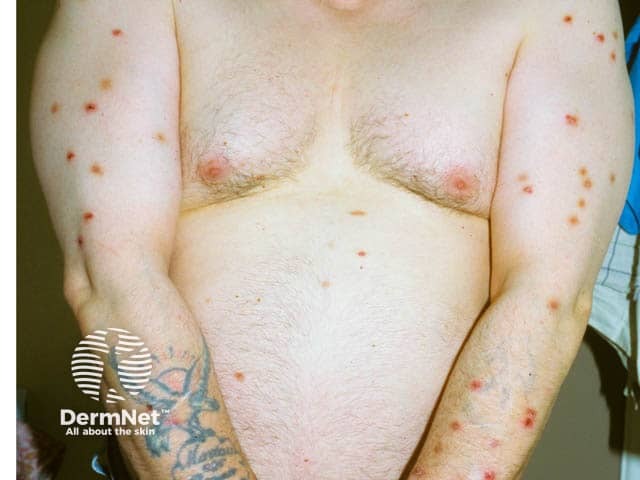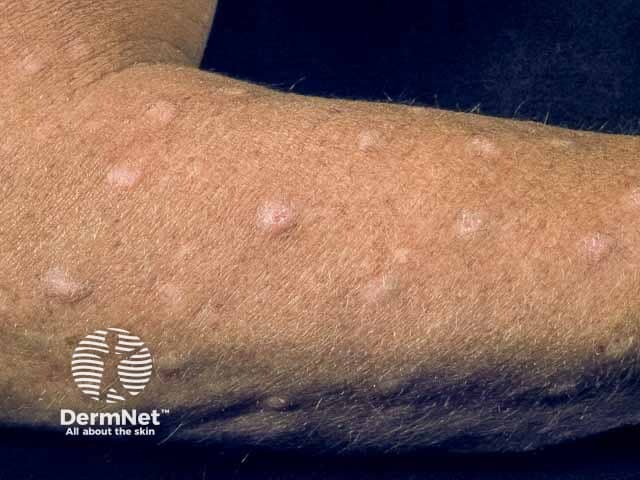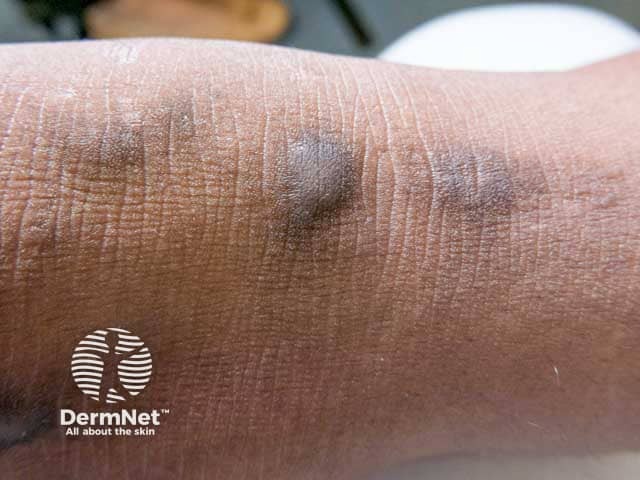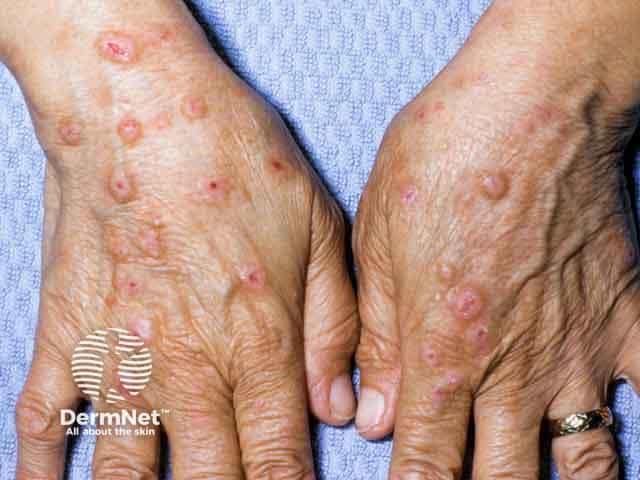Main menu
Common skin conditions

NEWS
Join DermNet PRO
Read more
Quick links
Nodular prurigo — extra information
Nodular prurigo
Author: Dr. Rui Baptista Gonçalves, Leeds Teaching Hospitals, United Kingdom. Copy edited by Gus Mitchell. July 2022
Introduction
Demographics
Causes
Clinical features
Variation in skin types
Complications
Diagnosis
Differential diagnoses
Treatment
Outcome
What is nodular prurigo?
Nodular prurigo (NP) or prurigo nodularis is a chronic skin condition characterised by very itchy firm lumps. It can appear anywhere on the body but is most common on the arms, legs, back, and torso, in a symmetrical distribution.
It is the most severe form of prurigo and thus can be difficult to treat.

Excoriated papules on the arms in nodular prurigo

Nodular prurigo on the arms

Excoriated prurigo lesions on the legs

Pigmentation of prurigo nodules in skin of colour (NP-patient3)

Prurigo on the dorsal hands in skin of colour

Dome shaped prurigo on the ankles
Who gets nodular prurigo?
Nodular prurigo can affect both sexes and people of all ages but is more common in older adults.
There is also an association with:
- Atopy (predisposition to asthma, atopic dermatitis, and hayfever)
- Drugs that produce chronic itch such as antimalarials, opioids, and targeted cancer treatments
- Internal disease such as:
- Cancer
- Diabetes
- Liver disease
- Chronic kidney disease
- HIV/AIDS
- Thyroid disorders.
What causes nodular prurigo?
The exact cause of prurigo nodularis remains unknown. It is thought to relate to a dysregulation of the nerves as skin biopsies have shown a greater number of nerve cells in the dermis but a reduced amount in the epidermis. There is also an increased number of Merkel cells in the epidermis and the papillary layer of the dermis, as well as more neutrophils and mast cells, thus more cytokine release; which may explain the severe itchiness.
The itchiness may start as a result of an insect bite, stress, dermatitis, or another underlying skin or systemic condition. There is also an association with brachioradial pruritus, which results from traction of spinal nerves in the neck. Scratching will thicken and inflame skin, worsening the condition.
What are the clinical features of nodular prurigo?
Nodular prurigo can vary in severity, from a few to hundreds of lesions of varying size.
Initially, the rash:
- Consists of small, red or pink bumps (usually 3–8 mm in diameter)
- Is intensely itchy
- Has a hyperpigmented border
- Is located in easily accessible areas of the body – lateral aspects of the arms and legs, shoulders, chest, and buttocks
- In some cases, presents as a papule before developing into a nodule or a plaque.
Scratching leads to:
- Enlargement resulting in a nodular, raised, warty surface
- Nodules tend to be firm and small but can measure up to 3 cm in diameter
- Older nodules are normally darker and are surrounded by paler, dry skin
- Nodules are grouped and follow a symmetrical distribution
- Some may ulcerate increasing infection risk
- Healed lesions can leave a scar or discolouration
- Affected skin may harden and thicken (hyperkeratotic).
How do clinical features vary in differing types of skin?
In darker skin, the lesions tend to be firmer, larger, and darker, similar to bumps on the skin that leave dark spots when healing, which can take longer to fade than in fairer skin types.
What are the complications of nodular prurigo?
Aside from its chronicity, the main complications are:
- Automatic scratching behaviour that may develop in the absence of pruritus
- Local infection.
How is nodular prurigo diagnosed?
Prurigo nodularis is most often diagnosed clinically, however, investigations are often useful particularly to ascertain the cause. These include:
-
Skin biopsy — may be useful to confirm diagnosis.
- Marked thickening may appear quite abnormal, sometimes resembling squamous cell skin cancer.
- Nerve fibres and endings are markedly increased in size.
- Increased number of neural mediators known to cause itching and nerve growth.
- Inflammation.
-
Direct immunofluorescence — usually negative.
- Rarely, the blistering disease bullous pemphigoid can present as nodular prurigo (pemphigoid nodularis). Immunofluorescence reveals immunoglobulins in the BMZ below the epidermis. The prurigo nodules can be present for weeks or months before any blisters appear.
- Patch testing — to determine any underlying allergen trigger
- Blood tests — including FBC, liver, kidney, and thyroid function HIV tests to determine the presence of underlying systemic disease.
What is the differential diagnosis for nodular prurigo?
- Atopic dermatitis
- Pemphigoid nodularis
- Actinic prurigo
- Epidermolysis bullosa pruriginosa
- Lichen simplex
- Lichen planus
- Dermatillomania
- Nodular scabies
- Multiple keratoacanthomas
- Reactive perforating collagenosis
What is the treatment for nodular prurigo?
Unfortunately, there is no cure and treatment can be challenging. Therapy must be multimodal, also including treatment of any identified underlying condition.
Specific measures
Common treatment options include:
- Topical emollients
- Topical steroid cream or ointment — usually ultrapotent steroid and applied under hydrocolloid dressing or paste bandage occlusion, or steroid impregnated tape
- Topical capsaicin and tacrolimus 0.1% ointment for itch
- Calcipotriol/betamethasone ointment
- Local corticosteroid injection (eg, triamcinolone acetonide 10–40 mg/ml) into the nodules to reduce inflammation
- Sedating oral antihistamines
- Phototherapy with either UVB or photochemotherapy (PUVA)
- Systemic treatment with gabapentin, pregabalin, and naltrexone
- Occasionally, antibiotics may be used to treat locally infected skin (cellulitis).
Other treatment options include:
- Cryosurgery or excimer lasers have also been used to treat the nodular lesions
- In very severe, treatment-resistant lesions, immunosuppressive treatments such as short-course oral steroids, ciclosporin, methotrexate, or azathioprine can be prescribed to help reduce inflammation
- Thalidomide has been used in recalcitrant cases
- Dupilumab (an anti-IL 4 and 13 inhibitor monoclonal antibody used to treat eczema, asthma and chronic rhinosinusitis) has shown efficacy in clearing treatment-resistant NP lesions.
- The monoclonal antibody vixarelimab (targets the receptor for cytokines IL-31 and oncostatin M) and nemolizumab are currently being studied as a treatment for NP.
- Promising results seen from an RCT for the treatment of NP with abrocitinib monotherapy.
General measures
It is crucial that anyone suffering from NP stops scratching the lesions, as this can make the condition worse. Strategies that can help include:
- Keeping your mind busy
- Covering the affected area with an occlusive dressing; hydrocolloids generally adhere well
- Cooling the affected areas:
- Laying a cool flannel on the skin may reduce inflammation and help ease the itching — some people keep flannels in the fridge for this purpose
- Keep rooms to a cool temperature
- Avoid sleeping with heavy or multiple bedclothes
- Avoid wearing clothes made of synthetic fibres — cotton is preferable
- Replace soaps or shower/bath gels that may irritate the skin with emollient
- Apply emollients at least twice a day, especially if you have dry skin.
What is the outcome for nodular prurigo?
Prurigo nodularis can be difficult to treat, taking months or even years to clear and may not resolve completely, often rendering it a chronic condition. It is important that patients follow their dermatologist’s recommendations and report any issues with the treatment so that different approaches can be used.
Bibliography
- Kowalski EH, Kneiber D, Valdebran M, Patel U, Amber KT. Treatment-resistant prurigo nodularis: challenges and solutions. Clin Cosmet Investig Dermatol. 2019;12:163–172. Published 2019 Feb 28. doi:10.2147/CCID.S188070 Journal
- Kwatra SG. Prurigo Nodularis, JAMA Dermatol. 2022;158(3):336. doi:10.1001/jamadermatol.2021.5307. Journal
- Müller S, Bieber T, Ständer S. Therapeutic potential of biologics in prurigo nodularis. Expert Opin Biol Ther. 2022;22(1):47–58. doi:10.1080/14712598.2021.1958777. Journal
- Mullins TB, Sharma P, Riley CA, Sonthalia S. Prurigo Nodularis. In: StatPearls. Treasure Island (FL): StatPearls Publishing; September 14, 2021. PubMed
- Wieser J, Mercurio M, Somers K. Resolution of treatment-refractory prurigo nodularis with dupilumab: a case series. Cureus. 2020 Jun;12(6):e8737. Journal
- Williams KA, Huang AH, Belzberg M, Kwatra SG. Prurigo nodularis: Pathogenesis and management. J Am Acad Dermatol. 2020;83(6):1567–75. doi:10.1016/j.jaad.2020.04.182. Journal
On DermNet
- Nodular prurigo images
- Prurigo
- Dermatitis
- Lichen simplex
- Itch (pruritus)
- Actinic prurigo
- Pemphigoid nodularis
Other websites
- Nodular Prurigo — British Academy of Dermatology
- Prurigo Nodularis — NORD
